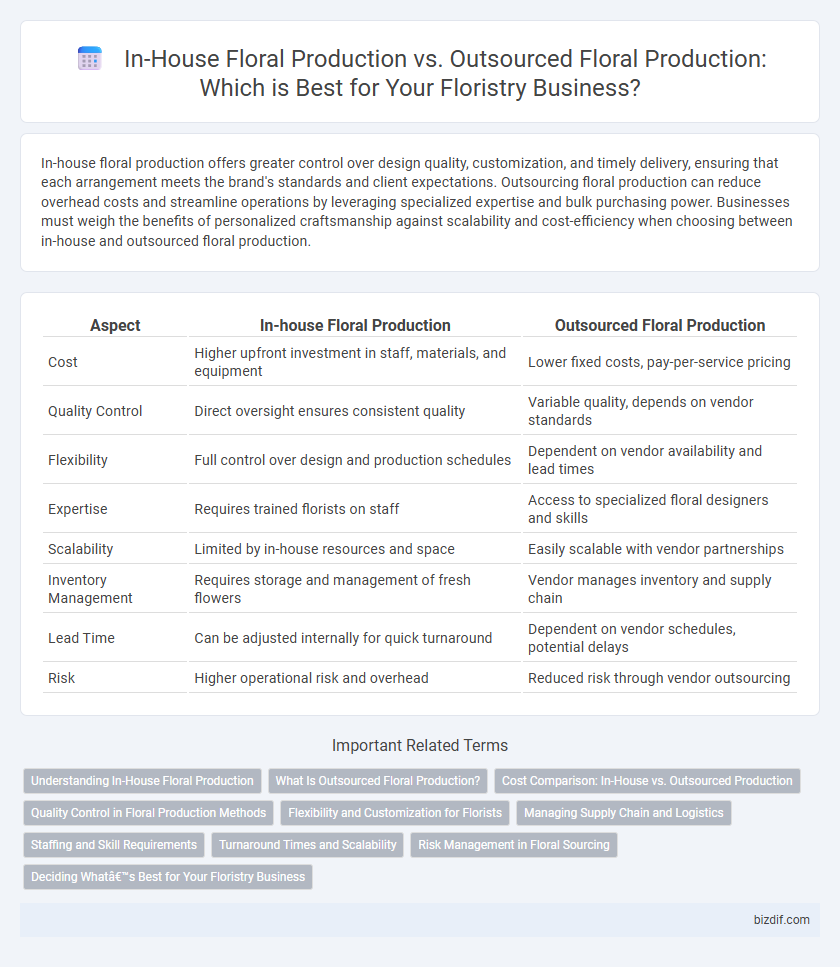In-house floral production offers greater control over design quality, customization, and timely delivery, ensuring that each arrangement meets the brand's standards and client expectations. Outsourcing floral production can reduce overhead costs and streamline operations by leveraging specialized expertise and bulk purchasing power. Businesses must weigh the benefits of personalized craftsmanship against scalability and cost-efficiency when choosing between in-house and outsourced floral production.
Table of Comparison
| Aspect | In-house Floral Production | Outsourced Floral Production |
|---|---|---|
| Cost | Higher upfront investment in staff, materials, and equipment | Lower fixed costs, pay-per-service pricing |
| Quality Control | Direct oversight ensures consistent quality | Variable quality, depends on vendor standards |
| Flexibility | Full control over design and production schedules | Dependent on vendor availability and lead times |
| Expertise | Requires trained florists on staff | Access to specialized floral designers and skills |
| Scalability | Limited by in-house resources and space | Easily scalable with vendor partnerships |
| Inventory Management | Requires storage and management of fresh flowers | Vendor manages inventory and supply chain |
| Lead Time | Can be adjusted internally for quick turnaround | Dependent on vendor schedules, potential delays |
| Risk | Higher operational risk and overhead | Reduced risk through vendor outsourcing |
Understanding In-House Floral Production
In-house floral production involves cultivating, designing, and assembling floral arrangements within a business's own facilities, allowing for greater control over quality, creativity, and customization. This approach enables real-time adjustments to inventory, faster turnaround times, and direct collaboration between florists and customers. Managing in-house production requires skilled floral designers and efficient resource allocation to maximize freshness and reduce waste.
What Is Outsourced Floral Production?
Outsourced floral production involves contracting external florists or specialized floral design companies to create arrangements instead of producing them in-house. This approach allows businesses to benefit from expert craftsmanship and access to diverse floral supplies without investing in extensive production facilities. Outsourcing can streamline operations, reduce labor costs, and provide scalability during peak seasons in the floristry industry.
Cost Comparison: In-House vs. Outsourced Production
In-house floral production often incurs higher upfront costs due to labor, equipment, and material investments but offers greater control over quality and customization. Outsourced floral production typically reduces operational expenses by leveraging the supplier's established infrastructure and bulk purchasing power, resulting in lower per-stem costs. Evaluating the total cost of ownership must include hidden expenses such as storage, waste management, and logistical coordination to determine the most cost-effective approach.
Quality Control in Floral Production Methods
In-house floral production offers superior quality control by allowing direct oversight of flower selection, conditioning, and arrangement processes, ensuring freshness and consistency. Outsourced floral production may introduce variability due to limited access to real-time quality monitoring and reliance on third-party vendor standards. Maintaining strict quality control protocols internally reduces the risk of damage during transport and guarantees timely customization based on client specifications.
Flexibility and Customization for Florists
In-house floral production offers florists unparalleled flexibility to quickly adjust designs and customize arrangements based on client preferences and seasonal availability. Outsourced floral production may limit rapid modifications due to standardized processes and shipping constraints, reducing the ability to provide tailored, last-minute designs. Florists prioritizing bespoke creations benefit significantly from maintaining direct control over production to meet unique customer demands and trends.
Managing Supply Chain and Logistics
In-house floral production enables tighter control over supply chain management by directly overseeing flower sourcing, inventory, and quality, which reduces delays and ensures freshness. Outsourced floral production relies on third-party vendors, requiring robust communication and coordination to manage logistics and maintain consistent delivery schedules. Efficient logistics in both models depend on synchronized transportation planning and real-time tracking to minimize waste and optimize stock levels throughout the distribution process.
Staffing and Skill Requirements
In-house floral production demands a dedicated team of skilled florists proficient in design, arrangement, and plant care, ensuring consistent quality and creative control. Outsourced floral production transfers staffing responsibilities to specialized vendors, reducing the need for in-house expertise but requiring effective coordination and quality assurance measures. Staffing flexibility differs, with in-house teams offering direct management and immediate adaptation, while outsourced services rely on vendor capabilities and delivery timelines.
Turnaround Times and Scalability
In-house floral production offers faster turnaround times due to direct control over the arrangement process, enabling immediate adjustments and quick fulfillment for last-minute orders. Outsourced floral production provides greater scalability by leveraging larger networks and bulk purchasing, accommodating high-volume demands without straining internal resources. Businesses seeking rapid response and quality control often prefer in-house setups, while those prioritizing expansion and seasonal spikes benefit from outsourcing.
Risk Management in Floral Sourcing
In-house floral production allows for direct oversight of quality control and reduces the risks associated with supply chain disruptions, ensuring fresher, more consistent blooms. Outsourced floral production can introduce variability in flower quality and delivery times, increasing the risk of inventory shortages and compromising event schedules. Effective risk management in floral sourcing involves assessing vendor reliability, diversifying suppliers, and maintaining buffer stock to mitigate potential supply chain failures.
Deciding What’s Best for Your Floristry Business
Evaluating in-house floral production versus outsourced floral production hinges on factors such as cost efficiency, quality control, and scalability tailored to your floristry business size and goals. In-house production offers direct oversight and customization but requires investment in skilled labor and equipment, while outsourcing can reduce operational complexities and provide access to specialized floral artisans. Analyzing customer demand patterns, budget constraints, and the desired brand experience ensures selecting the optimal production strategy for sustained growth and competitive advantage.
In-house Floral Production vs Outsourced Floral Production Infographic

 bizdif.com
bizdif.com